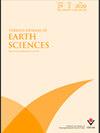Identification of transtensional and transpressional features in the Sea of Marmara using onshore-offshore seismic and geodetic data
IF 1.1
4区 地球科学
Q3 GEOSCIENCES, MULTIDISCIPLINARY
引用次数: 0
Abstract
: The scope of the study is to determine transtensional and transpressional features along the North Anatolian Fault beneath the Sea of Marmara, using seismic and geodetic data. For this purpose, focal mechanisms of small size NAF earthquakes, recorded by broadband stations and OBSs, have been derived and used as a tool to identify the transtensional and transpressional features. The focal mechanisms of: (1) small to moderate size events are obtained by the CMT inversion technique of Kuge (2003), using onshore waveform data from 2002–2015, (2) micro-earthquakes are obtained using the technique of Horiuchi (2015), using offshore waveform data recorded by 15 OBS stations from 2015–2016. Furthermore, published GPS velocities are used to determine the style of faulting and strain rates. The geodetic horizontal crustal strain rates are determined at equally spaced grid points by interpolating northing and easting components of the 112 GPS vectors from 1994–2013. The results indicate that extensional and strike-slip style deformation dominates the region, while contractional features are rare. Significant extension is observed in Çınarcık Basin and the area between Marmara Island and Central Basin. Yalova-Çınarcık region shows predominantly N-S extension while the Çınarcık Basin events show NE-SW extension. Compressional or transpressional features are derived to the west of Marmara Island and Ganos and in the Central segment extending from Central Basin toward Çınarcık Basin. The GPS strain rate results point out the highest values, 24 × 10 –8 /year, in Çınarcık Basin, while the lowest values, 11 × 10 –8 /year, are observed in Central Marmara. The highest strain rates in both edges of the fault segment in Çınarcık Basin can be indicative of a steadily creeping fault segment. In turn, lower strain rates in the Central Marmara region suggest that this segment of the NAF is locked.利用陆上-海上地震和大地测量资料识别马尔马拉海的张拉和张拉特征
:本研究的范围是利用地震和大地测量数据确定马尔马拉海下北安那托利亚断层沿线的转张和转压特征。为此,宽带台站和OBS记录的小规模NAF地震的震源机制已被推导出来,并被用作识别转张和转压特征的工具。(1)利用Kuge(2003)的CMT反演技术,利用2002-2015年的陆上波形数据,获得了中小型地震的震源机制;(2)利用Horiuchi(2015)的技术,利用2015-2016年15个OBS台站记录的海上波形数据,得到了微地震。此外,已公布的GPS速度用于确定断层类型和应变率。大地测量水平地壳应变率是通过插值1994-2013年112个GPS矢量的北向和东向分量,在等距网格点确定的。结果表明,伸展和走滑式变形在该地区占主导地位,而收缩特征很少。在Çınarcık盆地以及马尔马拉岛和中央盆地之间的地区观察到了显著的延伸。Yalova-Çınarcık地区主要表现为南北向延伸,而Çşnarcşk盆地事件则表现为东北-西南向延伸。马尔马拉岛和加诺斯西部以及从中央盆地向Çınarcık盆地延伸的中段均具有压缩或转压缩特征。GPS应变率结果指出,Çınarcık盆地的应变率最高,为24×10–8/年,而马尔马拉中部的应变率最低,为11×10–8/1年。Çınarcık盆地断层段两侧的最高应变速率可以表明断层段正在稳步蔓延。反过来,马尔马拉中部地区较低的应变率表明NAF的这一部分已被锁定。
本文章由计算机程序翻译,如有差异,请以英文原文为准。
求助全文
约1分钟内获得全文
求助全文
来源期刊

Turkish Journal of Earth Sciences
地学-地球科学综合
CiteScore
2.40
自引率
10.00%
发文量
6
审稿时长
6 months
期刊介绍:
The Turkish Journal of Earth Sciences is published electronically 6 times a year by the Scientific and Technological Research
Council of Turkey (TÜBİTAK). It is an international English-language journal for the publication of significant original recent
research in a wide spectrum of topics in the earth sciences, such as geology, structural geology, tectonics, sedimentology,
geochemistry, geochronology, paleontology, igneous and metamorphic petrology, mineralogy, biostratigraphy, geophysics,
geomorphology, paleoecology and oceanography, and mineral deposits. Contribution is open to researchers of all nationalities.
 求助内容:
求助内容: 应助结果提醒方式:
应助结果提醒方式:


